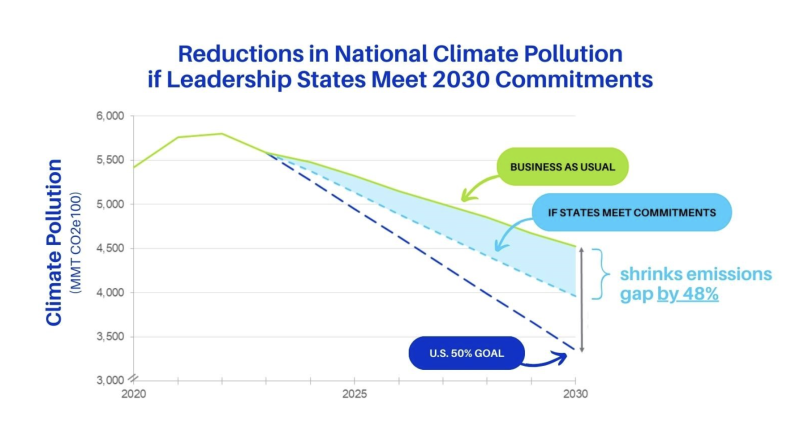Turning climate commitments into results
Climate leadership states could cut emissions gap to the U.S. commitment under the Paris Agreement in half, if governors achieve their targets.

In 2021, the U.S. set a goal to reduce emissions 50-52% below 2005 levels by 2030 as its Nationally Determined Contribution (NDC) to the Paris Agreement. It will take a “whole of government” approach — leveraging strong action at the federal and state level to achieve that goal and secure a safer, healthier future for our communities.
Climate leadership states are key
A new report from EDF, which includes updated 2023 emissions projections from Rhodium Group and the impact of federal clean energy investments, analyzes the role that states with climate commitments could play in driving national progress forward. We find that these states could shrink the nation’s remaining emissions gap in half — the distance between our projected emissions under current policy and our 2030 goal — if they pass ambitious and comprehensive policy needed to meet those commitments.

To get there, governors must go bold on limiting pollution, as our analysis finds they will fall short of their climate goals on their current path.
The urgency — and the opportunity — to move from climate pledges to policy has never been greater.
How states can meet their commitments and drive U.S. progress forward
With federal investments from the Inflation Reduction Act making clean energy cheaper than ever before, states have a golden opportunity to pass policy that secures reductions in climate pollution, builds clean energy jobs and lowers health-harming air pollution. EDF makes several policy recommendations for state leaders on how to make the most of this moment:
1. Set binding targets that achieve early and deep reductions
Mandatory targets that create an enforceable framework are key for reducing emissions at the pace and scale the climate crisis demands. Without mandatory targets, climate action could be stalled or rolled back by future state leaders.
2. Use existing authority to limit pollution
Regardless of state legislative inaction on climate solutions, governors committing to concrete pollution reduction targets can leverage existing authority to enact regulations that lower climate pollution.
3. Establish a declining, enforceable limit on emissions
A pollution limit — like Washington state’s economy-wide limit on emissions — is essential to provide a backstop for other complementary policies, guaranteeing the targeted emission cuts will be achieved regardless if other policies fall short.
4. Pair pollution limits with policies that catalyze development and deployment of clean technologies
Enforceable limits on climate pollution can work hand-in-hand with measures needed to accelerate clean technology deployment, like clean energy incentives, while providing the greatest possible certainty that states will reach their climate targets.
5. Consider an approach that puts a price on pollution
By pairing an enforceable pollution limit with a price on pollution, as the Regional Greenhouse Gas Initiative does, states can secure the needed level of emission reductions, while creating a price signal that incentivizes investments in clean energy technologies.
6. Ensure environmental and economic benefits are directed to disproportionately-impacted communities
Well-designed strategies for limiting climate pollution must be tailored to improve local pollution impacts and directly support clean energy deployment and economic benefits for the most overburdened and underserved populations.
Staff perspective
There’s never been a better time for states to use the sharpest tools they have available—policies that directly limit climate pollution from major emissions sources—to ensure they will deliver on their commitments.
Pam Kiely
Associate Vice President, U.S. Region
MEDIA CONTACT
Chandler Green
(803) 981-2211 (office)














